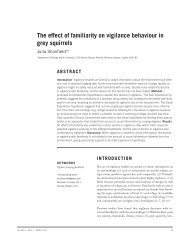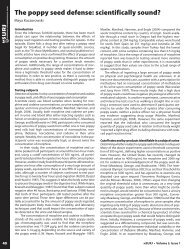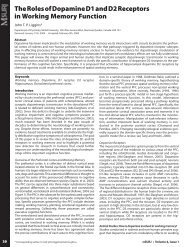the entire issue - McGill Science Undergraduate Research Journal ...
the entire issue - McGill Science Undergraduate Research Journal ...
the entire issue - McGill Science Undergraduate Research Journal ...
You also want an ePaper? Increase the reach of your titles
YUMPU automatically turns print PDFs into web optimized ePapers that Google loves.
Force-fluctuation physics of confined DNA: probing <strong>the</strong> breakdown of <strong>the</strong> Marko-Siggia law<br />
Analysis<br />
A movie of each studied molecule was opened as a three dimensional<br />
(two space and one time) matrix in MATLAB. At each frame,<br />
<strong>the</strong> brightest pixel of each row was calculated. Because <strong>the</strong> DNA is<br />
uniformly stained, maxima in recorded intensity serve as proxies for<br />
maxima in DNA concentration. For each row, an array of maximal positions<br />
over time was generated. The standard deviation of this array<br />
served as a measurement for <strong>the</strong> standard deviation of <strong>the</strong> position<br />
of <strong>the</strong> molecule at that point along its contour.<br />
A custom built MATLAB program was used to determine <strong>the</strong> extended<br />
contour length (L). The first step involved subtracting <strong>the</strong> background<br />
noise in <strong>the</strong> fluorescence video image. A box was manually<br />
aligned to each of <strong>the</strong> two nanopits that contained <strong>the</strong> trapped DNA<br />
molecule. The summed pixel intensity of <strong>the</strong> two boxes was determined,<br />
as well as <strong>the</strong> pixel intensity of <strong>the</strong> <strong>entire</strong> molecule. The ratio<br />
of <strong>the</strong> intensity in <strong>the</strong> two pits to <strong>the</strong> total intensity of <strong>the</strong> molecule<br />
was used as a proxy to calculate <strong>the</strong> extended contour length between<br />
<strong>the</strong> two pits because <strong>the</strong> total contour length (L T<br />
) of <strong>the</strong> molecule is<br />
known (19135 nm).<br />
Results<br />
It can be seen from <strong>the</strong> right half of Figure 2 that <strong>the</strong> standard deviation<br />
along <strong>the</strong> molecule increases as <strong>the</strong> position becomes fur<strong>the</strong>r<br />
from <strong>the</strong> pits, peaking at <strong>the</strong> mid-point. Baba et al. (2012) derived this<br />
relationship as parabolic. In order to establish commonality between<br />
<strong>the</strong>ir optical traps and our entropic traps, we examined this relationship.<br />
In Figure 3, <strong>the</strong> variance is plotted as a function of <strong>the</strong> longitudinal<br />
coordinate and it can be seen that <strong>the</strong> parabolic relationship<br />
described by Baba et al (8) does indeed hold. The variance peaks at<br />
<strong>the</strong> middle of <strong>the</strong> stretched part of <strong>the</strong> molecule and behaves according<br />
to <strong>the</strong> quadratic law about this position. In our experiments, <strong>the</strong><br />
DNA molecule was trapped at both ends, so <strong>the</strong> transverse fluctuation<br />
is symmetric about <strong>the</strong> midpoint. Once again, this result was also<br />
obtained by Baba et al (8) by using dual trap optical tweezers to trap<br />
<strong>the</strong> DNA molecule.<br />
It was previously mentioned (3) that DNA behaves differently under<br />
confinement. We also postulated that <strong>the</strong> Marko-Siggia force-extension<br />
relationship (7) is not ideal to describe a DNA molecule under<br />
confinement. We measured <strong>the</strong> magnitude of transverse fluctuations<br />
of DNA in 500 nanometer pits separated by 1000 nanometers across<br />
slit heights ranging from 50 to 170 nanometers (Figure 4). We used<br />
<strong>the</strong> statistical <strong>the</strong>ory of Reisner et al (9) to calculate <strong>the</strong> equilibrium<br />
conformation of <strong>the</strong> molecule, and coupled this result to <strong>the</strong> forcefluctuation<br />
relationship of Baba et al (8). to generate a <strong>the</strong>oretical<br />
prediction. As a comparison, we examined <strong>the</strong> two-dimensional limit<br />
of this relationship and <strong>the</strong> effective persistence described by Chen<br />
et al (12). In Fig.4, <strong>the</strong> Marko and Siggia 3D force-fluctuation curve is<br />
shown in red and <strong>the</strong> curve in blue is derived from <strong>the</strong> two dimensional<br />
limit of <strong>the</strong> force-fluctuation model. It can be seen in Fig.4,<br />
that <strong>the</strong> data points are bounded by <strong>the</strong> 3D and 2D force fluctuation<br />
curves and nei<strong>the</strong>r model adequately describes <strong>the</strong> behavior of <strong>the</strong><br />
data across all regimes. The fact that <strong>the</strong> 3D force law does not ad<br />
Fig. 2<br />
Analysis to determine standard deviation. Left: A histogram of peak<br />
positions in a 3000 frame movie. The micrograph in <strong>the</strong> center of<br />
<strong>the</strong> histogram corresponds to a straight molecular configuration,<br />
while <strong>the</strong> o<strong>the</strong>r micrograph corresponds to a molecule fluctuation<br />
to <strong>the</strong> left. Right: The standard deviation of peak intensities, as a<br />
function of position along <strong>the</strong> nanoslit. The plateaus at <strong>the</strong> edges<br />
correspond to random noise, <strong>the</strong> two valleys correspond to <strong>the</strong><br />
molecular contour trapped in <strong>the</strong> pits, and <strong>the</strong> peak between <strong>the</strong>m<br />
represents <strong>the</strong> actual transverse fluctuations of <strong>the</strong> molecule.<br />
Fig. 3<br />
Variance along molecular position for a DNA molecule. The molecule<br />
is trapped in a nanopit-nanoslit sytem with a slit height of 110<br />
nm and with pits separated by 2000 nm. We find agreement with<br />
Baba et al.’s [6] assertion that variance behaves parabolically with<br />
distance from <strong>the</strong> end points.<br />
46<br />
<strong>McGill</strong> <strong>Science</strong> <strong>Undergraduate</strong> <strong>Research</strong> <strong>Journal</strong> - msurj.mcgill.ca









